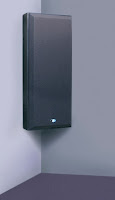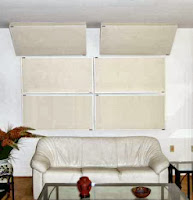 |
| Figure 1: 12 room angles |
"Bass frequencies bounce around the room but eventually find their way to the corners, which then act as a waveguide and focus them back into the room. They’re the greatest culprits for bass buildup, and require treatment in order to tame the low frequency peaks that every room has. That’s why even if you’ve built an effective Reflection Free Zone, you still need as many bass traps as you can get to even out the low frequency bumps that will inevitably occur. The good news is that the more bass traps you have, the less it matters where you place the traps.
 |
| Figure 2: Floor to ceiling trap |
It is important to remember that the purpose of a bass trap is not to reduce the amount of low end you hear in a room, but to reduce their destructive reflections and thereby even out any low frequency level fluctuations that occur in untreated rooms (especially those with solid walls). With enough bass trapping, the low end will sound tighter and more predictable, and will change less when you move away from the sweet spot.
There are 12 corners in a rectangle room (see Figure 1 on the left) and all of them are candidates for trapping. The front wall corners are usually the easiest to treat because no one walks there and you don’t lose any space as a result. The ideal is to fill them with floor to ceiling bass traps (see Figure 2), but the eight corners where the walls and ceiling and walls and floor come together should suffice (see Figure 3).
 |
| Figure 3: Corner trap |
The traps don’t all have to be the same size since bass is non-directional. As a result, the total surface coverage is more important than symmetry (this is not the case for mid/high frequency absorbers however, where symmetry is important). That being said, it’s best if the traps are spread around the room in as many corners as possible.
When acoustic panels are placed straddling the corners (see Figure 4), there’s an inherent air gap that makes the trap more effective because it helps their ability to absorb low frequencies. It’s even better if you can fill up the space with regular insulation like R-13. Thicker panels are always better for corner traps, although lighter weight ones make them easier to hang. Bass traps that extend floor to ceiling work the best because they maximize the way they absorb low frequencies.
 |
| Figure 4: Acoustic panels at corners |
You can build bass traps yourself as we’ve outlined in Chapter 3, or you can buy them pre-made from a number of suppliers like Real Traps, GIK Acoustics, PrimeAcoustic, Ready Acoustics and MSR Acoustics among others."
You can read additional excerpts from The Studio Builder's Handbook and others at bobbyowsinski.com.
----------------------------------
You should follow me on Twitter and Facebook for daily news and updates on production and the music business.
Don't forget to check out my Music 3.0 blog for tips and tricks on navigating social media and the new music business.


1 comment:
Thanks for this excerpt.
Post a Comment